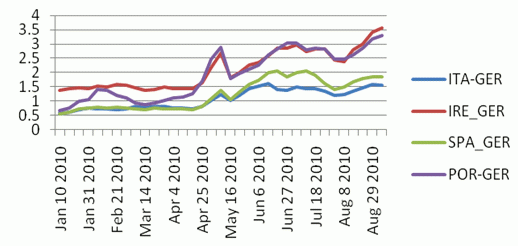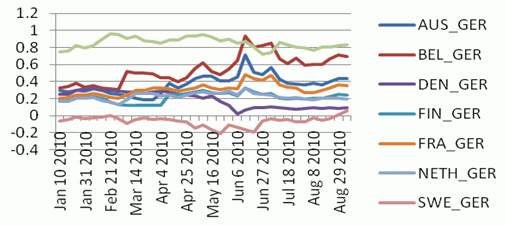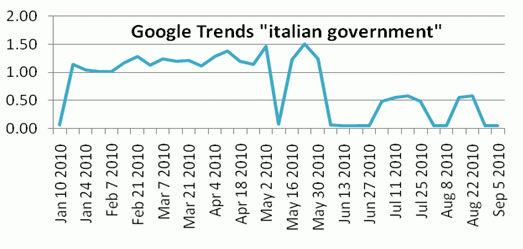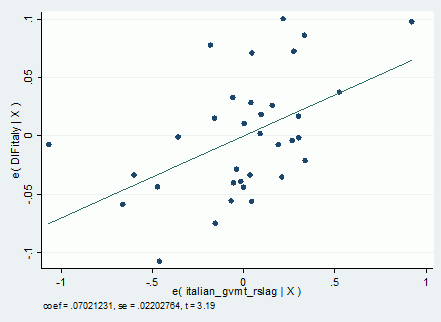Across Europe, coalition governments are taking a battering. In April, the Belgian coalition government collapsed after only five months. In the UK, just four months after forming its first coalition government in over 30 years, the ruling parties enter their annual conferences already on the defensive. In the Netherlands, three months after elections, the country is still waiting for a new government as coalition talks have stalled. Many commentators will emphasise the need for “stable government”; here we examine Italy’s coalition government to identify whether that cliche is true.
The Italian government run by Silvio Berlusconi is currently facing a serious political crisis. The new troubles originated from the growing conflict between the Prime Minister Silvio Berlusconi and the Chairman of the Chamber of Deputies Gianfranco Fini – the two founders of the majority Party of the People. The crisis led to the expulsion of Fini. His subsequent foundation of a new political movement, formed by several Members of Parliament, has eroded the support for the government in both Houses. In the last few months, the government has been paralysed by internal conflicts that have raised the uncertainty on the duration of the legislature. Our analysis shows that the economic costs of the present political instability are likely to be substantial (Manasse and Trigilia 2010).
Spreads and political uncertainty
From the start of 2010, long-term interest rates on government bonds in southern Europe (+ Ireland) and northern Europe have diverged. Figure 1 shows the spreads of European “middle risk” (Italy, Ireland, Portugal, and Spain) government bonds with respect to the German Bund. As of April 2010, these spreads have shown an upward trend; they tripled in Italy, Ireland, and Spain and quintupled in Portugal (Greek spreads, not shown in the Figure, reached 9 points, quadrupling since the beginning of the year)
Figure 1. Ten-year spreads in southern Europe and Ireland
Source: Data Stream
Conversely, interest spreads in the rest of Europe, with the notable exceptions of Belgium, Austria and France, have remained flat, as shown in Figure 2.
Figure 2. Ten-year spreads in northern Europe
Source: Data Stream
Thus one may be tempted to conclude that the recent political instability in Italy, at least so far, has not substantially eroded the international credit rating of the country, which has moved roughly in line with other European “middle risk” countries. Unfortunately, the evidence does not support this conclusion.
The literature on sovereign debt crises in emerging markets suggests that political instability is often associated with an increase in both the level and the volatility of spreads, as well as with a rise in the frequency of sovereign defaults (Cuadra and Sapriza 2008). In particular, the uncertainty caused by the closeness to elections, together with a fixed exchange rate and the necessity of refinancing a large amount of debt, is one of the best early warning sign for debt crisis (Manasse and Roubini 2009).
How costly is this political instability for the Italian public finances? In order to answer this question we followed an unusual path. We used Google Trends, a service that allows us to obtain weekly data on the relative frequency of Google searches. Early use of Google Trends include Varian and Choi (2009) and Manasse (2009) (see also D’Amuri and Marcucci 2009). We used the intensity of searches containing the words “italian government”” as a proxy for the (interest in) the Italian political crisis. This variable has the nice property that its peaks closely correspond to events that clearly measure an increase in the “political temperature” of the debate (see Figure 3 below and Manasse and Trigilia 2010, for an Appendix containing a list of the events that correspond to the variable’s peaks).
Figure 3. Perceived political instability
Source: Google Trends
Controlling for many other possible influences on Italian government ten-year yields, including the other southern-European-countries’ rates and international factors, we have found a positive and significant relationship between the change in government yield and our measure of political instability. The partial correlation, i.e. net of other influences, is shown in Figure 4.
Figure 4. Partial correlation between change in Italian ten-year yield (DIF Italy) and political instability (italian_gvmt_rslag)
As an application, we have measured the effects of this August’s campaign against the Gianfanco Fini, President of the Chamber of Deputies. Mr.Fini was accused (by the press owned by the Berlusconi family) of having favoured members of his family over a house sale in Monte Carlo. Our estimates suggest that this political row was associated with a five basis point increase in the government yield, which, if sustained and applied to all maturities, would add about €830 million to the interest bill.
We think that our results apply more generally. Coalition governments are known to be associated with high spending (Persson et al. 2007). Our evidence supports the view that financial markets immediately price more factious coalitions into higher risk premia. Europe is now facing the task of sustaining and gradually reducing very large debt volumes, while at the same time, in Iceland, Latvia and Romania to the Netherlands, Belgium, Germany, the UK and Italy, coalition governments are becoming more commonplace. To us, these developments are likely to make the necessary adjustment even more difficult and painful.
References
Cuadra G and H Sapriza (2008), “Sovereign Default, Interest Rates and Political Uncertainty in Emerging Markets”, Journal of International Economics, 76(1):78-88.
D’Amuri, Francesco and Juri Marcucci (2009), “The predictive power of Google data: New evidence on US unemployment”, VoxEU.org, 16 December.
Manasse P and N Roubini (2009), “Rules of Thumb for Sovereign Debt Crises”, Journal of International Economics, September,192-205.
Manasse, P (2009): “Berlusconi: Private Leisure and Public Costs of the Sultan of Swing”, roubini,com
Manasse P and G Trigilia (2010), “Il costo dell’instabilità politica” (in Italian, Google Translator friendly).
Persson, Torsten, Gerard Roland, and Guido Tabellini (2007), ” Electoral Rules and Government Spending, in Parliamentary Democracies”, Quarterly Journal of Political Science, 2(2):155-188
Varian, H and H Choi (2009), “Predicting the Present with Google Trends”, Google Research Blog.





